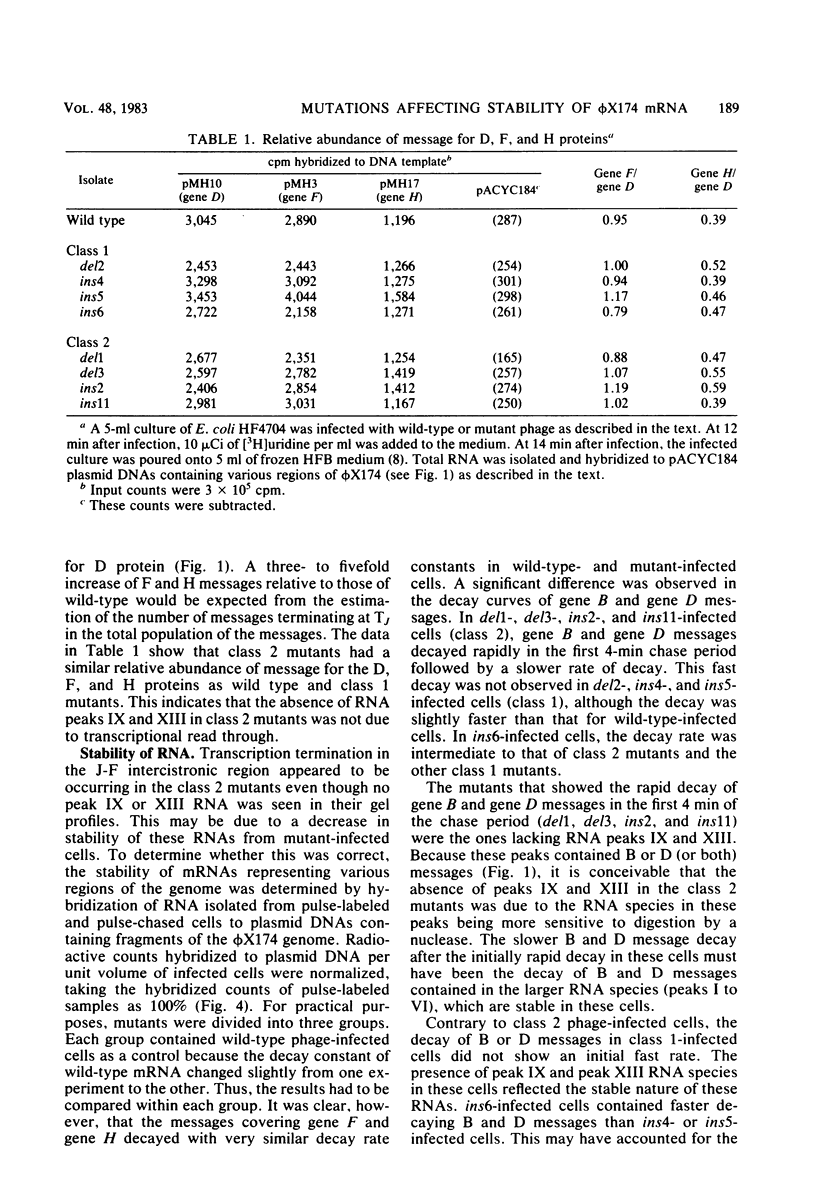Abstract
A hairpin-like secondary structure in the intercistronic region between genes J and F of bacteriophages, phi X174 and G4 has been postulated to act as a transcription termination signal. We analyzed the in vivo transcripts of both phages and mutants derived from them with modifications of this hairpin structure. The phi X174 mutants appeared to fall into two groups with respect to the stability of two mRNA species. Class 1 mutants showed an mRNA profile very similar to the parental strain, whereas class 2 mutants lacked two major mRNA species normally terminated near the J-F region. The G4 mutants behaved like class 2 mutants of phi X174. Analysis of the stability of phi X174 mRNA revealed that messages specific for the genes upstream of the hairpin turn over more rapidly in class 2 mutants than in class 1 mutants. In class 1 mutants, the mRNA decay rates are similar but not identical to those of the wild-type strain. These data suggest a role for the nucleotide sequence within the J-F intercistronic region in mRNA degradation. They further imply that transcription termination occurs downstream from this site.
Full text
PDF










Selected References
These references are in PubMed. This may not be the complete list of references from this article.
- Axelrod N. Transcription of bacteriophage phi-X174 in vitro: selective initiation with oligonucleotides. J Mol Biol. 1976 Dec 25;108(4):753–770. doi: 10.1016/s0022-2836(76)80115-5. [DOI] [PubMed] [Google Scholar]
- Birnboim H. C., Doly J. A rapid alkaline extraction procedure for screening recombinant plasmid DNA. Nucleic Acids Res. 1979 Nov 24;7(6):1513–1523. doi: 10.1093/nar/7.6.1513. [DOI] [PMC free article] [PubMed] [Google Scholar]
- Clements J. B., Sinsheimer R. L. Process of infection with bacteriophage phiX174. XXXVII. RNA metabolism in phiX174-infected cells. J Virol. 1975 Jan;15(1):151–160. doi: 10.1128/jvi.15.1.151-160.1975. [DOI] [PMC free article] [PubMed] [Google Scholar]
- Fiddes J. C., Godson G. N. Nucleotide sequence of the J gene and surrounding untranslated regions of phage G4 DNA: comparison with phage phiX174. Cell. 1978 Nov;15(3):1045–1053. doi: 10.1016/0092-8674(78)90288-x. [DOI] [PubMed] [Google Scholar]
- HAYASHI M. N., HAYASHI M., SPIEGELMAN S. CHROMATOGRAPHIC SEPARATION OF ANNEALED AND ENZYMATICALLY SYNTHESIZED RNA-DNA HYBRIDS. Biophys J. 1965 Mar;5:231–246. doi: 10.1016/s0006-3495(65)86713-3. [DOI] [PMC free article] [PubMed] [Google Scholar]
- Hayashi M. N., Hayashi M., Imai M. Bacteriophage phi X174-specific mRNA synthesis in cells deficient in termination factor rho activity. J Virol. 1981 Apr;38(1):198–207. doi: 10.1128/jvi.38.1.198-207.1981. [DOI] [PMC free article] [PubMed] [Google Scholar]
- Hayashi M. N., Hayashi M. Isolation of phi X174 specific messenger ribonucleic acids in vivo and identification of their 5' terminal nucleotides. J Virol. 1972 Feb;9(2):207–215. doi: 10.1128/jvi.9.2.207-215.1972. [DOI] [PMC free article] [PubMed] [Google Scholar]
- Hayashi M. N., Hayashi M. Stability of bacteriophage phi X174-specific mRNA in vivo. J Virol. 1981 Jan;37(1):506–510. doi: 10.1128/jvi.37.1.506-510.1981. [DOI] [PMC free article] [PubMed] [Google Scholar]
- Hayashi M., Fujimura F. K., Hayashi M. Mapping of in vivo messenger RNAs for bacteriophage phiX-174. Proc Natl Acad Sci U S A. 1976 Oct;73(10):3519–3523. doi: 10.1073/pnas.73.10.3519. [DOI] [PMC free article] [PubMed] [Google Scholar]
- Linney E., Hayashi M. Intragenic regulation of the synthesis of phi chi 174 gene A proteins. Nature. 1974 May 24;249(455):345–348. doi: 10.1038/249345a0. [DOI] [PubMed] [Google Scholar]
- Müller U. R. Enzymatic construction and selection of bacteriophage G4 mutants with modifications of a DNA secondary structure in the J-F intercistronic region. J Virol. 1983 Oct;48(1):170–179. doi: 10.1128/jvi.48.1.170-179.1983. [DOI] [PMC free article] [PubMed] [Google Scholar]
- Müller U. R., Wells R. D. Intercistronic regions in phi X174 DNA. I. Construction of mutants with altered intercistronic regions between genes J and F. J Mol Biol. 1980 Jul 25;141(1):1–24. doi: 10.1016/s0022-2836(80)80026-x. [DOI] [PubMed] [Google Scholar]
- Müller U. R., Wells R. D. Intercistronic regions in phi X174 DNA. II. Biochemical and biological analysis of mutants with altered intercistronic regions between genes J and F. J Mol Biol. 1980 Jul 25;141(1):25–41. doi: 10.1016/s0022-2836(80)80027-1. [DOI] [PubMed] [Google Scholar]
- Roth T. F., Hayashi M. Allomorphic forms of bacteriophage phiX-174 replicative DNA. Science. 1966 Nov 4;154(3749):658–660. doi: 10.1126/science.154.3749.658. [DOI] [PubMed] [Google Scholar]
- Sanger F., Coulson A. R., Friedmann T., Air G. M., Barrell B. G., Brown N. L., Fiddes J. C., Hutchison C. A., 3rd, Slocombe P. M., Smith M. The nucleotide sequence of bacteriophage phiX174. J Mol Biol. 1978 Oct 25;125(2):225–246. doi: 10.1016/0022-2836(78)90346-7. [DOI] [PubMed] [Google Scholar]
- Smith L. H., Sinsheimer R. L. The in vitro transcription units of bacteriophage phiX174. II. In vitro initiation sites of phiX174 transcription. J Mol Biol. 1976 Jun 5;103(4):699–710. doi: 10.1016/0022-2836(76)90204-7. [DOI] [PubMed] [Google Scholar]


